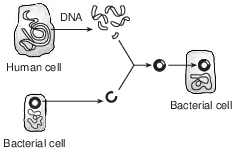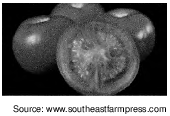Topic: Technology Of Genetic Engineering
Technology Of Genetic Engineering
The diagram below represents a technique used in some molecular biology laboratories.

Which phrase best describes a possible result of this process?
(1) the production of gametes having both human and bacterial DNA
(2) the production of a human hormone by the bacterial cell
(3) the introduction of a pathogen into a human cell
(4) the separation of DNA fingerprints in the bacterial cell
A scientist plans to cut a segment of DNA so that it can be inserted into the DNA of a bacterium, a single-celled organism. The scientist needs to use a special type of organic molecule to perform this cutting process. This molecule is
(1) a lipid
(2) a carbohydrate
(3) an enzyme
(4) a hormone
The diagram represents a process used to modify bacterial cells.

In the diagram, arrows labeled X and Y represent the use of
(1) clones
(2) receptors
(3) genes
(4) enzymes
A laboratory technique is represented in the diagram below. Letter A represents a process.

Which specific chemicals are needed to success- fully carry out the process shown at A?
(1) receptor molecules
(2) carbohydrates
(3) enzymes
(4) starch molecules
The diagram below represents a scientific technique in use today.

Scientists have used this technique to
(1) produce hormones for human use at a lower cost than other methods
(2) produce pathogens that are able to live in humans
(3) clone human cells with desired characteristics
(4) eliminate the need for laboratory production of medicines for humans
The diagram below shows some of the DNA in a bacterium into which a human gene, X, has been successfully inserted.

The bacteria that result from reproduction of this cell will most likely have the ability to
(1) replicate all of the genetic instructions found in humans
(2) produce vaccines to be used to immunize humans
(3) produce a human blood cell according to instructions in gene X
(4) produce the human protein coded for by gene X
Researchers have produced rice plants that can withstand being completely submerged for up to two weeks. This is good news for farmers in the flood regions of Southeast Asia. The farmers in this region rely heavily on this crop. The diagram below illustrates the process used to genetically modify plants, such as rice.

The molecules used to cut, copy, and connect the DNA segments used in this process are
(1) sugars
(2) enzymes
(3) indicators
(4) antigens
The diagram below represents a laboratory process.

The substance represented by the scissors shown cutting the DNA is
(1) an enzyme
(2) a starch molecule
(3) a carbohydrate
(4) a fat molecule
Which molecules are needed to cut and copy segments of DNA?
(1) reproductive hormones
(2) carbohydrates
(3) antibodies
(4) biological catalysts

The process represented in the diagram is
(1) DNA replication
(2) natural selection
(3) gel electrophoresis
(4) genetic engineering
Phosphorus is necessary for the growth of healthy plants. Scientists are developing plants that can grow in phosphorus-poor soil. Some of these new varieties, produced in a lab, make extra copies of a protein that helps them obtain more phosphorus from the soil. The process being used to develop these new varieties is most likely
(1) paper chromatography
(2) natural selection
(3) direct harvesting
(4) genetic engineering
The organic compounds that scientists use to cut, copy, and move segments of DNA are
(1) carbohydrates
(2) enzymes
(3) hormones
(4) starches
Transgenic (GMO) Tomatoes
The use of pesticides to control insects costs billions of dollars every year. Genetically modified organisms (GMOs) are an attempt to reduce this cost. Tomato plants that are genetically modified can make proteins that are poisonous to the insects that feed on them. Using these GMO tomatoes would reduce the need for the chemical control of insects.

Identify the type of chemical substance a scientist would need to use to cut and paste the genes to produce genetically modified tomato plants. [1]
Allow 1 credit. Acceptable responses include, but are not limited to:
• — an enzyme
• — a restriction enzyme
• — a biological catalyst
Discuss the process used by scientists to insert a gene from one organism into the DNA of another. In your answer, be sure to:
• identify the scientific technique used to insert a gene from one organism into another [1]
• describe the function of a gene [1]
• identify the type of molecule used to cut the gene from the DNA of an organism [1]
• state one benefit of this technique to humans [1]
The student’s response to the bulleted items in the question need not appear in the following order.
• 14 Allow 1 credit for identifying the scientific technique used to insert a gene from one organism into
• another. Acceptable responses include, but are not limited to:
• — genetic engineering
• — genetic recombination
• — genetic manipulation
• — gene splicing
• Note: Do not allow credit for biotechnology. It is a field of science, not a technique.
• 15 Allow 1 credit for describing the function of a gene. Acceptable responses include, but are not
• limited to:
• — a segment of DNA that codes for a protein
• — Genes control traits.
• — Genes carry genetic information form one generation to the next.
• 16 Allow 1 credit for identifying the type of molecule used to cut the gene from the DNA of an
• organism. Acceptable responses include, but are not limited to:
• — enzyme
• — restriction enzyme
• — biological catalyst
• 17 Allow 1 credit for stating one benefit of this technique to humans. Acceptable responses include,
• but are not limited to:
• — make medicines for humans
• — increase the yield of crops
• — use plants to produce vaccines
• — produce needed hormones (chemicals) for humans
• — introduce new traits/characteristics into an organism
The work of a cell is carried out by the many different types of molecules it assembles. Most of these molecules are proteins. Explain how the cell is able to make the many different proteins it needs. In your answer, be sure to:
• identify where in the cell the information necessary to construct a particular protein is located and the specific molecule that contains this information [1]
• identify both the cellular structure that assembles these proteins and the kinds of molecules that are used as the building blocks of the proteins [1]
The student’s response to the bulleted items in the question need not appear in the following order.
• 18 Allow 1 credit for identifying where in the cell the information necessary to construct a particular protein is located and the specific molecule that contains this information. Acceptable responses include, but are not limited to:
• — The information is in DNA molecules in the nucleus of the cell.
• — The nucleus contains the DNA molecules where the information is found.
• — The information is located on a chromosome, which contains DNA.
• 19 Allow 1 credit for identifying both the cellular structure that assembles these proteins and the kinds of molecules that are used as the building blocks of the proteins. Acceptable responses include, but are not limited to:
• — Ribosomes construct proteins out of amino acids.
• — Ribosomes use amino acids to assemble proteins.
• — Ribosomes use amino acids.
